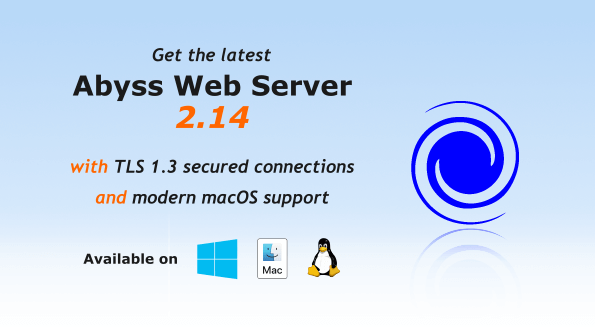
- #Php mysql with abyss web server install
- #Php mysql with abyss web server update
- #Php mysql with abyss web server software
- #Php mysql with abyss web server zip
In the popup window, enter php and click OK. Click “Add” in the “Associated Extensions” table.
#Php mysql with abyss web server update
Change the “Type” to “PHP Style” and make sure the “Use the associated extensions to automatically update the Script Paths” box is checked. Don’t select the php.exe or php-win.exe file, use php-cgi.exe, which is explicitly for FastCGI usage. Then click Browse next to the “Interpreter” and select the php-cgi.exe file in the extracted PHP6 snapshot folder. On that page, set the “Interface” to “FastCGI (Local – Pipes)”. Then click “Add” in the “Interpreters” table. On the Scripting Parameters page, make sure that “Enable Scripts Execution” is checked. On the resulting page, click on “Scripting Parameters”. Click “Configure” for the default host (note that your default host may run on a port other than 80 if you have another Web server installed). After you register and login, you’ll be brought to the Abyss Web Server Console. Much of this information comes from Abyss’ own documentation for installing PHP, but with my own images (click the appropriate links to see them). After you’ve installed Abyss, start it up and you can configure it for PHP. The Abyss installation process is really simple and needs no further explanation from me (check the official documentation if you have questions). For this article, I used version X1, which is free.
#Php mysql with abyss web server install
Next you need to download and install Abyss. I extracted all of my files into a newly created C:\php6 directory.

#Php mysql with abyss web server zip
The downloaded file is a ZIP that needs to be extracted. For Windows running Apache or Abyss, you want to download the file named PHP 6.0 – Windows x86 VC6 (thread safe). As I write this, that page has snapshots available for three versions of PHP: 5.2, 5.3, and 6.0. Note that snapshots are not intended for production use. For example, a snapshot may be what PHP6 looks like at Februat midnight.
#Php mysql with abyss web server software
A snapshot, in case you’re not familiar with it, is just a reflection of the software at a moment in time. You can also use Internet Information Services (IIS), the Microsoft Web server, but I’m much less familiar with it. In this example, I’ll use Abyss, from Aprelium, a nice, simple to use, lightweight alternative to Apache. So as not to have the PHP6 installation conflict or harm any existing PHP setups, I would recommend using another Web server for PHP6. Generally I advise beginning Windows users to install something like XAMPP, which is an easy, no-nonsense all-in-one packager for PHP, Apache, MySQL and more.

Normally I would run PHP through Apache, even on Windows. No matter what version of PHP you’re using, you need to run it through a Web server (unless you’re using it for command-line purposes only). In this post, I’ll walk you through that process for Windows users (I’ll address non-Windows users separately).


In order to do so, you’ll need to do what I did in order to write the book: install a beta version of PHP6 on your computer. Still, some users reading the book (rightfully) want to test or play with the forthcoming, primarily Unicode-related, features I discuss in those two chapters. Obviously the situation isn’t ideal but only two chapters in the book require PHP6, and some features originally intended for PHP6 have been added to PHP5. Such are the potential problems when it comes to writing about open source software: you really never know what you’re going to get or when. Now, just over a year later, there’s no news on PHP6 and, from what I gathered, there’s not a pressing drive to get it out anytime soon, either. This is a big deal, so I thought I’d include support for PHP6 in the book. The primary alteration in PHP6 is support for Unicode, a change that Ruby is also making in version 1.9. PHP5 had been out some time and PHP6 was more than 50% ready to go. When I went to write the third edition of my PHP 6 and MySQL 5 for Dynamic Web Sites: Visual QuickPro Guide book, I had to decide what version of PHP to support.


 0 kommentar(er)
0 kommentar(er)
